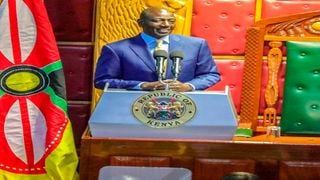
President William Ruto in Parliament on Thursday, November 9, 2023, during the State of the Nation address.
Politics
Premium
Behind-the-scenes look at Ruto’s State of the Nation address
What you need to know:
- President Ruto used a teleprompter to deliver his message, a marked departure from his predecessors.
- The address took exactly one hour and six minutes.
President William Ruto’s State of the Nation speech yesterday took exactly one hour and six minutes as he outlined his achievements over the past one year.
Dr Ruto used a teleprompter, a marked departure from his predecessors, to deliver his message to a half-empty House, with most Opposition MPs keeping away.
Ceremonial outriders
At exactly 14.28pm, President Ruto’s motorcade, complete with the ceremonial outriders, made stop outside Parliament Buildings ahead of the address.
He was received by his deputy, Mr Rigathi Gachagua, Speakers Moses Wetang’ula (National Assembly) and Amason Kingi (Senate) and their deputies,.
Also at hand to receive the Head of State were Clerks Samuel Njoroge (National Assembly) and Jeremiah Nyegenye (Senate).
The president was escorted to the Senate lounge where he signed the visitors’ book.
The Senate lounge is situated on the ground floor of Parliament Buildings.
It also acts as his waiting area whenever he visits parliament. It is here that he met with the Speakers, the majority and minority leaders and the Clerks of the two Houses for briefing and consultation before he made his way into the debating chamber of the National Assembly to deliver his address.
As the President was being briefed in the Senate holding room, First Lady Rachel Ruto and Ms Dorcas Rigathi, the Deputy President’s wife, were led by parliamentary protocol officers to their respective holding rooms and then later to the Speaker’s row in the National Assembly ready for the address.
At the Senate lounge, the Clerk of the National Assembly, Mr Njoroge, made brief remarks, introduced the parliamentary staff and later informed the Deputy President, Deputy Speakers and the party leaders to proceed to the chamber.
At 14.51pm, the President was escorted from the holding area, to the debating chamber of the National Assembly led by a procession of two Sergeants-At-Arms bearing the maces of the two House, followed by the two House Clerks.
Two anthems
Behind the Clerks were the two Speakers with the President just behind them.
At 14.55pm, President Ruto assumed the chair reserved for the Speaker or an individual presiding over debate in the House as Speaker Wetang’ula sat on his right with Speaker Kingi on the left.
Once in the House, the Speaker of the Senate delivered the prayers.
The two anthems were played once again before the traditional prayer that precedes every start of the business in the House, was delivered by Speaker Kingi.
The convocations by the two Speakers would then follow.
After the two Speakers had read their convocations to their respective members alerting them that the joint special sitting was properly convened, it was the turn of the President.
Make his remarks
At 15.02pm, National Assembly Speaker Wetang’ula invited the President to make his remarks and at 16.08pm, the President ended his address to the nation.
A minute later, he left the chamber back to the holding area for another round of consultation and briefing.
After the address, the adjournment of the two Houses followed, first with the Senate Speaker adjourning the Senate and his National Assembly counterpart adjourning the National Assembly and inviting the guests to the reception at the main courtyard at Parliament Buildings.
The procession then left the chamber, followed by the members of the two Houses.





